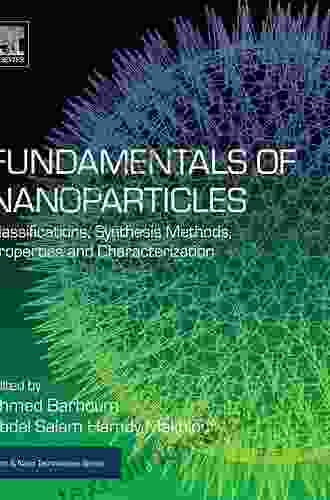Unveiling the Intricacies of Micro and Nanomaterials: Classifications, Synthesis, Properties, and Characterization

4.2 out of 5
| Language | : | English |
| File size | : | 51218 KB |
| Text-to-Speech | : | Enabled |
| Screen Reader | : | Supported |
| Enhanced typesetting | : | Enabled |
| Print length | : | 647 pages |
In the realm of advanced materials, micro and nanomaterials have emerged as game-changers, revolutionizing industries from electronics to healthcare. Their exceptional properties and versatility have opened up a plethora of applications, but understanding their intricacies is crucial for harnessing their full potential. In this comprehensive guide, we delve into the world of micro and nanomaterials, exploring their classifications, synthesis methods, unique properties, and advanced characterization techniques.
Classifications of Micro and Nanomaterials
Micro and nanomaterials are broadly classified based on their size, structural dimensions, and morphology. Here are the primary classifications:
1. Microparticles:
* Size range: 1 micrometer to 100 micrometers * Properties: Similar to bulk materials, but with increased surface area and reactivity
2. Nanoparticles:
* Size range: 1 nanometer to 100 nanometers * Properties: Exhibit unique optical, electronic, and magnetic properties due to quantum effects
3. Nanofibers:
* Size range: Diameter less than 100 nanometers * Properties: High strength-to-weight ratio, flexibility, and potential for electrical conductivity
4. Nanotubes:
* Size range: Diameter less than 100 nanometers * Properties: Exceptional electrical and thermal conductivity, high surface area, and mechanical strength
5. Nanowires:
* Size range: Diameter less than 100 nanometers * Properties: Semiconducting or metallic properties, high carrier mobility, and potential for electronic and optoelectronic applications
Synthesis Methods for Micro and Nanomaterials
The synthesis of micro and nanomaterials involves precise control over their size, shape, and properties. Here are some common synthesis techniques:
1. Chemical Synthesis:
* Utilization of chemical reactions to form nanoparticles or nanocrystals * Methods include precipitation, sol-gel, and hydrothermal synthesis
2. Physical Synthesis:
* Employs physical processes such as evaporation, condensation, and mechanical milling * Techniques include ball milling, sputtering, and laser ablation
3. Biological Synthesis:
* Harnessing the capabilities of living organisms, such as bacteria or plants, to produce nanomaterials * Offers environmentally friendly and scalable synthesis routes
Unique Properties of Micro and Nanomaterials
The small size and unique structural features of micro and nanomaterials endow them with remarkable properties:
1. Enhanced Surface Area:
* Increased surface-to-volume ratio leads to improved reactivity, adsorption capacity, and catalytic efficiency
2. Quantum Confinement Effects:
* Nanoparticles exhibit size-dependent quantum effects, resulting in altered optical, electronic, and magnetic properties
3. Mechanical Strength:
* Nanomaterials, such as carbon nanotubes and nanofibers, possess exceptional strength and toughness, despite their small size
4. Electrical Conductivity:
* Nanomaterials can exhibit high electrical conductivity, making them promising candidates for electronic devices
5. Thermal Conductivity:
* Some nanomaterials, such as carbon nanotubes, exhibit high thermal conductivity, enabling efficient heat dissipation
Advanced Characterization Techniques
Characterizing micro and nanomaterials requires specialized techniques to analyze their size, shape, composition, and properties. Here are some advanced methods:
1. X-Ray Diffraction (XRD):
* Determines the crystal structure and phase composition of materials
2. Transmission Electron Microscopy (TEM):
* Provides high-resolution images of materials, revealing their atomic structure and morphology
3. Scanning Electron Microscopy (SEM):
* Captures surface topography and elemental composition of materials
4. Atomic Force Microscopy (AFM):
* Measures surface roughness, topography, and local mechanical properties
5. Dynamic Light Scattering (DLS):
* Determines the size distribution and hydrodynamic radius of nanoparticles in solution
Applications of Micro and Nanomaterials
The exceptional properties of micro and nanomaterials make them indispensable in a wide range of applications:
1. Electronics:
* Miniaturization of devices, enhanced performance, and improved energy efficiency
2. Healthcare:
* Drug delivery systems, tissue engineering, and biosensors
3. Energy:
* Solar cells, batteries, and fuel cells
4. Environmental Remediation:
* Water purification, air pollution control, and waste management
5. Aerospace:
* Lightweight materials, thermal management, and sensor technologies
Micro and nanomaterials represent a transformative class of materials with enormous potential to shape the future. By understanding their classifications, synthesis methods, unique properties, and characterization techniques, we can harness their capabilities in a myriad of applications. This comprehensive guide provides a thorough to the fascinating world of micro and nanomaterials, empowering researchers, engineers, and industry professionals to unlock their full potential.
4.2 out of 5
| Language | : | English |
| File size | : | 51218 KB |
| Text-to-Speech | : | Enabled |
| Screen Reader | : | Supported |
| Enhanced typesetting | : | Enabled |
| Print length | : | 647 pages |
Do you want to contribute by writing guest posts on this blog?
Please contact us and send us a resume of previous articles that you have written.
 Book
Book Novel
Novel Page
Page Chapter
Chapter Text
Text Story
Story Genre
Genre Reader
Reader Library
Library Paperback
Paperback E-book
E-book Magazine
Magazine Newspaper
Newspaper Paragraph
Paragraph Sentence
Sentence Bookmark
Bookmark Shelf
Shelf Glossary
Glossary Bibliography
Bibliography Foreword
Foreword Preface
Preface Synopsis
Synopsis Annotation
Annotation Footnote
Footnote Manuscript
Manuscript Scroll
Scroll Codex
Codex Tome
Tome Bestseller
Bestseller Classics
Classics Library card
Library card Narrative
Narrative Biography
Biography Autobiography
Autobiography Memoir
Memoir Reference
Reference Encyclopedia
Encyclopedia Mariana Enriquez
Mariana Enriquez Marvin Himel
Marvin Himel Scott Donaldson
Scott Donaldson Rachel Rosenthal
Rachel Rosenthal Michael Ferrari
Michael Ferrari Marshall Mason
Marshall Mason Leia Stinnett
Leia Stinnett Roberto Moro Visconti
Roberto Moro Visconti Sharon Creech
Sharon Creech Scott Motto
Scott Motto Mario Geymonat
Mario Geymonat Melissa Troup
Melissa Troup Michael C Thomsett
Michael C Thomsett Mia Alexander
Mia Alexander Shari Cross
Shari Cross Maya Thoresen
Maya Thoresen Maria Yiangou
Maria Yiangou Marilyn Faneite
Marilyn Faneite Melissa Smith
Melissa Smith Meg Woodward
Meg Woodward
Light bulbAdvertise smarter! Our strategic ad space ensures maximum exposure. Reserve your spot today!

 Marvin HayesIntroduction to Combinatorics: A Comprehensive Guide for Mastering Counting...
Marvin HayesIntroduction to Combinatorics: A Comprehensive Guide for Mastering Counting... Ernest HemingwayFollow ·16k
Ernest HemingwayFollow ·16k August HayesFollow ·14k
August HayesFollow ·14k Alfred RossFollow ·19.5k
Alfred RossFollow ·19.5k Greg CoxFollow ·2.2k
Greg CoxFollow ·2.2k Bob CooperFollow ·14.1k
Bob CooperFollow ·14.1k Gerald BellFollow ·7k
Gerald BellFollow ·7k Aubrey BlairFollow ·9.9k
Aubrey BlairFollow ·9.9k James JoyceFollow ·14k
James JoyceFollow ·14k

 Boris Pasternak
Boris PasternakThree Walking: An Immersive Journey into the Heart of...
Immerse yourself in the...

 Connor Mitchell
Connor MitchellUnveiling the Secrets of Archery: Discover "Learnt It...
Archery, an...

 Craig Blair
Craig BlairUnveiling the Secrets of Success: Arrogance Millz Day
Are you ready to unlock...

 Damon Hayes
Damon HayesThe Diary and Letters of America's Minister to France...
In the year 1870, as the...

 Hector Blair
Hector BlairCapoeira: A Journey Through History, Culture, and the...
Origins and...
4.2 out of 5
| Language | : | English |
| File size | : | 51218 KB |
| Text-to-Speech | : | Enabled |
| Screen Reader | : | Supported |
| Enhanced typesetting | : | Enabled |
| Print length | : | 647 pages |












